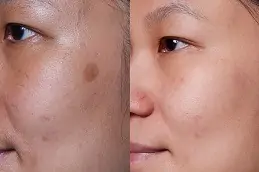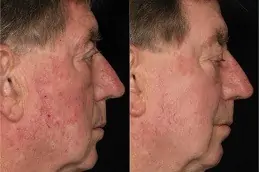Results of Actinic Keratosis USA:
After the treatment, skin starts to clear up, and the redness and inflammation reduction. If you avoid sun damage and UV radiation, it will not return.
Who gets Actinic Keratosis?
It is not a consequence of recent sunburn but the result of repeated slight photodamage to the skin from exposure to sunlight. Most often affected are people with fair skin who have difficulty tanning because their skin contains less protective pigment; they are most susceptible to sunburn.
Because actinic keratosis usually takes years of sun exposure to develop, generally, older adults are most affected.
How Does Actinic Keratosis Progress?
Each actinic keratosis can develop in three scenarios. This is important when planning your treatment:
- Actinic keratosis may regress. This means that it disappears on its own without treatment.
- Actinic keratosis may persist. That is, it remains, does not change, but does not disappear either.
- Actinic keratosis can sometimes develop into skin Disease cancer.
Treatments of Actinic Keratosis:
The choice of treatment method is determined by the number of affected areas, their size, the duration of the disease, the desired cosmetic results, and the patient’s wishes. There are currently several methods of treatment for actinic keratosis:
- Curettage
- Dermabrasion
- Laser Resurfacing
- Chemical peels
- Photodynamic therapy
Curettage:
It is a type of surgical intervention to remove a mass using curettage. This method is considered very outdated and is rarely used for the treatment of actinic keratosis due to its insufficient effectiveness, as well as the frequent cosmetic defects of the skin after its implementation, the duration of the restoration of the skin and the recurring infection of the area of its implementation due to insufficient patient adherence to the doctor’s recommendations for caring for the corresponding zone.
Dermabrasion:
Diamond cutters or wire brushes with a rotation speed in the range of 800 to 33 thousand rpm are used. The inconvenience of the method is that the patient must be in the hospital for at least a week.
Laser Resurfacing:
Treatment with laser destruction of Actinic Keratosis in Georgia & Tbilisi occurs by resurfacing the upper layers of the skin. It is used only in the initial stages of the disease and has several contraindications associated with the presence of related diseases and old age.
In addition, the cosmetic problems arising after the application of these methods of treatment greatly aggravate the socio-psychological, interpersonal relationships for most patients, often causing anxiety and a decrease in the quality of life.
Chemical Peels:
Chemical peels are a non-invasive method of aggressively exfoliating the skin cells that make up actinic keratosis. After making sure you are suitable for a chemical peel, your doctor will apply a thin layer of the solution to the lesions.
Trichloroacetic acid (TCA) is often the chemical of choice for treating these bumps. The TCA solution is left on the lesion for approximately 10-15 minutes. The doctor can then apply a chemical neutralising solution before cleaning the area.
Photodynamic Therapy:
Photodynamic therapy solves the issue of adverse cosmetic consequences, and more than others, it meets the requirements of a doctor and a patient. However, the economic costs of providing medical organisations with laser devices and photosensitisers limit its widespread use.
In the last 20 years, special attention has been drawn to the possibility of using hyperthermia laser-induced thermotherapy (LITT) as an independent organ-preserving treatment technology for some solid human tumours. The LITT method is based on local heating of the neoplasm to 43–45 ° C using a laser, the wavelength range from 800 to 1064 nm.
Actinic Keratosis Treatment Faq’s:
Is Actinic Keratosis A Cancer?
Skin cancer with squamous cells can develop from certain actinic keratoses. The lesions are frequently referred to as precancer as a result. They offer no threat to life. However, they do not have the opportunity to progress to skin cancer if they are discovered and treated quickly.
What Is The Fastest Way To Get Rid Of Actinic Keratosis?
The fastest form of treatment is cryotherapy. It can be completed in your healthcare provider's office and only takes a few minutes. Actinic keratosis is also currently treated with techniques such as curettage, dermabrasion, laser Resurfacing, chemical peels, and photodynamic therapy.
Can Actinic Keratosis Disappear On Its Own?
Actinic keratosis typically isn't a major problem and disappears on its own. It's essential to have them examined because they may eventually develop into skin cancer.
Can Actinic Keratosis Be Surgically Removed?
Yes, it can be! Your dermatologist will carefully remove the growth and some of the surrounding skin in the affected area using a surgical knife. The targeted region is then sewn together.
How Big Can Actinic Keratosis Get?
Actinic keratosis range in size from 2 to 6 mm on average, but they can get bigger. Growth has a higher probability of turning into skin cancer by the time it reaches a diameter of 10 mm or half an inch.
What Is The New Treatment For Actinic Keratosis?
It is widely believed that laser treatment will eliminate actinic keratosis better than other treatments. Actinic keratosis is being treated with this method more and more frequently. Your physician will remove the patch with an ablative laser device so that new skin can grow in its place.
Is Actinic Keratosis Painful?
Very rare but Actinic keratosis lesions can burn, itch, stick to your clothes, or even bleed when touched. They can also feel sensitive as well.
Why Choose Us?
Actinic keratosis seems like a harmless condition in the beginning but it can progress into something as severe as skin cancer. A condition like this should never be ignored in any case. We have trained and experienced professionals at Sydney Royal Clinic who can help you deal with this problem effectively.
Book a Free Appointment
Don’t ignore actinic keratosis and contact Royal clinic Georgia today to get the best treatment in Actinic Keratosis in Georgia, Tbilisi. Fill out the consultation form now to book a free consultation with our competent and experienced doctors.





